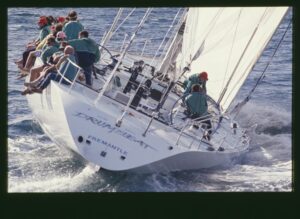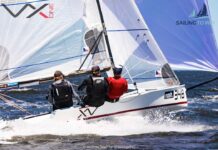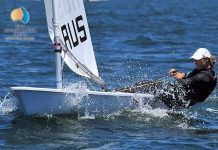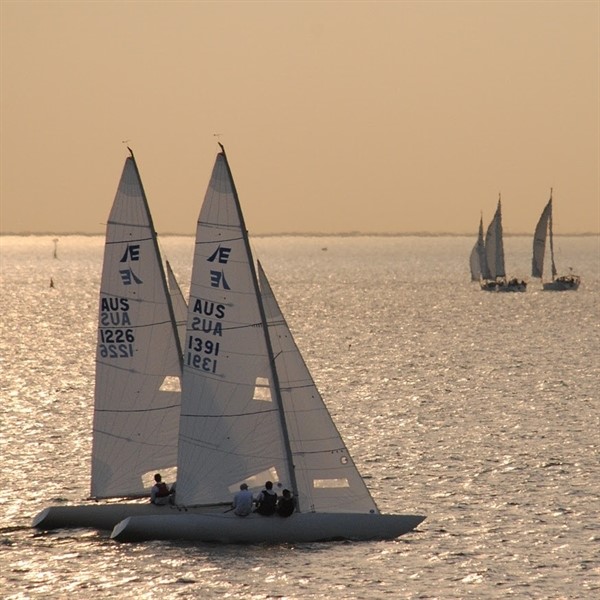
I interviewed Skip Lissiman about sailing practice and training, excerpts from that interview are copied below.
Skip has sailed just about everything from Pelicans and Cherubs through J24s, Etchells, 12 Metres and Maxi boats.
He’s also sailed in every position from bowman to sailing master. Skip was in the crew of Australia 2 when they won the America’s Cup in 1983. He sailed for Australia in the Admiral’s Cup and the Kenwood Cup, plus a multitude of other offshore events.
Some of those include the Fastnet Race, Plymouth to Freemantle, Transatlantic Race, and 6 Sydney to Hobart. Newport to Bermuda and this is just to name a few.
Skip is also an accomplished match racer and has won six grade-one match racing events.
Brett: Is there any aspect of the sport you reckon can’t be learned? I mean, you often hear about somebody who’s a natural. I believe sailing’s one of those sports, where you’re always learning. You don’t ever know it all.
Skip: Well, every natural yachtsman that I’ve ever sailed with has always started at a very young age.
Picking up the sport when you’re older will be harder to learn the skills than at a younger age. I can’t stress enough the importance of kids getting into the sport and doing the hard yards in the Opti’s and the dinghy classes.
The learning that you do after that, sailing with other people and other classes, will upskill you to a point where you get better and better.
You’ve just got to get out there and do it as young as you can If you pick it up later in life, then read a lot, watch a lot, sail a lot. Especially sail with people better than you and you’ll slowly pick up the skills.
Brett: What age did you start, Skip, as a matter of interest?
Skip: I started about age 6 and really didn’t get into dinghy sailing big time until I was probably about 12.
Brett: I’ve read a lot of biographies of great sailors and five or six seems to be the magic starting time. Do you reckon there’s any part of sailing where natural ability will trump someone who has to learn and practice the skill?
Skip: Well, each class is different. The modern moth type classes where you sail faster than the wind is a totally different sort of skillset to sailing a slower moving boat like a Dragon, 12 Metre or a 5.5 that tack slowly and carries its speed through the tack.
Each type of class has got a different skill set in how you use the wind shifts and the wind itself. You’ve got to apply the skills differently for each kind of boat that you’re sailing and what the wind patterns are doing.
There’s no easy way around it. The guys that are very good at it have a knack of seeing the different ripples on the water and they can tell generally whether it’s a lift or knock before the wind actually gets to them.
That’s a skill that you can only get good at by watching the gusts as they come to you and seeing what the boat does. Over time you get better and better at it. And if you get it right more often than you get it wrong, you’re halfway there.
Brett: Once again, that comes back to time on the water in a lot of cases, because some people are slower than others to pick that stuff up too.
Skip: Yep. Some people never really get it.
Brett: Outside sailing, what do you do as part of the training if you were training for say an Etchells regatta for instance? What would you do off the boat other than gym work to keep fit? Is there another sport you’d play for instance?
Skip: I do a lot of bike riding and do some static weights. I don’t go to gyms generally.
The one thing that really is important on a boat is good balance and good upper arm or upper body strength and core strength. If you’re hiking all day on any type of boat, you need core strength. You need upper body strength to be able to pull on the sheets and do the things you need.
So free weights exercises that give you good stamina. Bike riding does that very, very well. A lot of the Olympic athletes have bikes and they do a lot of bike work as well as static weights.
I use an exercise ball and free weights and do that after I get home from a bike ride and that’s enough for me. I’ve been doing more or less the same exercise routine now for the last 35, 40 years. I’m still the same weight as I was when I did my first America’s Cup 40 years ago.







